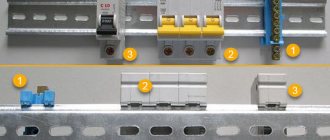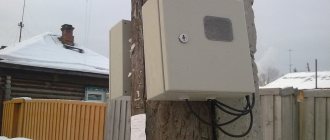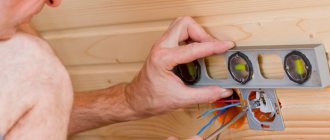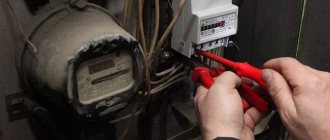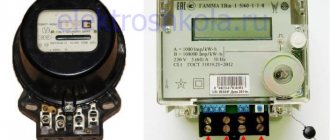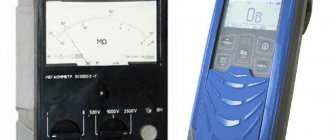Author of the article
Alexander Georgievich Kondratiev
An electrical engineer by training, he worked as an electronics engineer, chief engineer at a food company, and general director of a construction organization.
Before you begin installing an electric meter in a private home, you need to carefully study the rules. They differ significantly from the conditions for installing an electricity meter in an apartment. Typically, such metering devices are installed outdoors. This is necessary so that the energy sales inspector can easily check the status of the meter and monitor the readings.
Starting from July 1, 2022, new rules for installing metering devices will apply. Resolution of the Government of the Russian Federation dated April 18, 2020 N 554 “On introducing amendments to certain acts of the Government of the Russian Federation on improving the organization of electrical energy metering” was approved. Now electric networks install meters at their own expense, free of charge for the consumer.
According to the new law, all property will be equipped not with ordinary meters, but with “smart” ones - intelligent means of electricity metering (ISEM). For now, these are only recommendations, and from January 1, 2022, only smart devices will be allowed to be installed.
Who should install an electric meter and at whose expense
Before the law was issued, the responsibility for purchasing and installing metering devices was assigned to the owner. From July 1, 2022, there have been significant changes in legislation.
Now the purchase, installation of an electricity meter in a private house or apartment, and its commissioning are entrusted to the organization supplying electricity. In the private sector, these are electrical networks. This issue has been removed from consumers: the owner does not have to buy an electric meter, pay for installation and verification. For residents, this is conditionally free: the electric network will not present a separate bill for the device, but these costs are included in the tariff by default.
The owner must fulfill the following requirements:
- In private houses with three-phase power supply there must be a grounding loop. Parameters and permission to operate electrical equipment are issued by the electrical measuring laboratory;
- Provide access to power engineers to install the meter. At the same time, the owner must take into account that to check the functionality and take readings, free access to the electric meter is provided at any time. This involves installing an electric meter in a private house on the street. That is, it is mounted on the facade of a house, a fence or a free-standing support.
Do-it-yourself meter installation
If the problems with the installation location are resolved, then you can begin installing the electric meter. In addition to the metering device, according to the installation rules you will need:
- A metal or composite cabinet designed to protect electric meters. In addition to the usual metal box, cabinets with forced ventilation, alarm, heating and anti-vandal design are available;
- Packet for inclusion in the supply circuit at the entrance to the electric meter. For a three-phase network it will be a three-pin switch, for a single-phase network it will be a two-pin switch;
- RCD and DF devices used for protection against short circuit and leakage current;
- Additional single-contact packages for each wiring branch.
It is clear that in addition to instruments and a cabinet, you will need to buy a corrugated hose and 3-5 meters of two-core cable of the appropriate cross-section, with rubber insulation. In addition, according to the rules, it will be necessary to make a grounding loop and connect the grounding bus to the installation site of the electric meter.
Which electric meter to choose for installation
First of all, it is worth remembering that the model purchased for installation in a private home must be certified and verified. The validity period of the verification certificate for three-phase units is 1 year from the date of production, for single-phase units - 2 years. Otherwise, the device will have to be sent to a specialized company, which is a little more expensive and an order of magnitude faster than in state calibration laboratories. Today, new electricity meters are produced with a calibration interval of 16 years.
The second point that makes sense to pay attention to is the operating and limiting current. Usually for a single-phase network it is 25A, for a three-phase network - 32A. Electricity meters for currents over 100A are connected via a current transformer. The maximum power consumption for a private house is 30 kW.
An electric meter with a conventional mechanical indication is best suited for a private home. Models with an electronic liquid crystal screen are controlled by a digital board with a controller and a memory board. No matter what manufacturers say or advertise, mechanics are still more reliable than electronics.
The third factor is price and reputation. All options for installing an electric meter under preferential or budget programs, as a rule, are designed for installation of the cheapest models at $15-20 per device. There is no point in installing such electricity meters for your private home, even for free. Firstly, such metering devices shamelessly lie by 10-15% in the direction of increase, and secondly, they break down in the hundreds, replacement or re-installation will cost much more than buying a high-quality model.
Under no circumstances should the electric meter be installed on a pole or on a façade. Such proposals should be immediately deleted from the contract. No matter how reliable the device is, condensation and frost will kill it in three to four years.
Today, electricity meters with memory and the ability to wirelessly connect to computers for diagnostics and reading data on electricity consumption are actively advertised. Perhaps for apartments and cottage villages with their own transformer, installing such a device makes sense, but for most electrical networks in the suburbs and the private sector, this option is unlikely to be suitable. The basic rule of technology is that the simpler the device, the longer it works.
Assembling the meter in an installation cabinet
For installation, choose a place in the hallway or hallway of the house. Most often, the cable supply from the power pole is carried out through an intermediate support in the courtyard of the house. Your task is to install the cabinet, bring the cable in the corrugation to the support, connecting the cable to the line is assigned to the specialists of the energy network company. In addition to the overhead connection scheme, it is allowed to supply the cable to the house through a plastic or underground asbestos pipe. But in this case, the company will require that the cabinet with the electric meter be placed on a pole outside the household.
If you have agreed to the remote option of installing a cabinet with an electric meter, no one cares how you will continue to run the cable into the house. You can install supports or bury it to a depth of 0.7-0.9 m, as required by the rules. You just need to make a panel with packages to disconnect individual wiring segments and equip the grounding.
The cabinet is a box made of thin sheet metal with a door. Inside the box there are fasteners that facilitate the installation and installation of the main devices - the input package, the electric meter and the packages on the wiring distribution.
The input package, like an electric meter, is always equipped with an additional cover covering the contacts. The lid must have an industrial “ear” or cell for sealing.
The contacts from the input cable are connected to the package according to the diagram shown.
Next, you need to connect the phase and zero wires to the meter input; for this, use copper pieces of wire in colored polyvinyl chloride insulation. For installation, according to the rules, it is necessary to use copper wire with a cross-section of 1 mm2 per 10 amperes of current, but in practice, installation is carried out with a small margin - in sections with a cross-section of 5 mm2. Choose a dark wire for the phase wiring, a light one for the zero line, and follow this rule for all electrical wiring and installation of current consumers in the house.
The meter pin diagram for connecting the wiring is always provided on the body or cover of the device as an aid to installation. If you open the terminal box, it will become clear that the input and output of the phase wire are on the left, the inlet and outlet of the neutral wire are on the right.
Owner's procedure
Installing a new meter requires certain steps. They are not much different if the meter has expired or has broken down and needs to be replaced with a new one.
There is a certain procedure that the owner must follow when installing the meter.
To do this he must:
- Contact the energy sales office with an application, which will be reviewed within 7 days;
- To do this, you will need the owner’s passport or a power of attorney if the application is submitted by another person;
- The inspector will require proof of ownership. It is necessary to provide a purchase and sale agreement, deed of gift, etc.;
- Permit, technical specifications and project for installation of electrical equipment. Ground loop test report. It is provided with a three-phase connection;
- A date is agreed upon for the inspector to visit to check the correct installation of electrical equipment. The inspector must arrive no later than 15 days from the date of filing the application;
- Electrical equipment is being installed. It can be installed on its own, if the owner has the appropriate skills, or by an invited electrician;
- An act is drawn up in two copies; if installation and commissioning is carried out by a third-party organization, the number of acts will be three. It indicates the owner’s data, meter type, primary readings, seal number.
The acts are signed by all interested parties and take their copies. The owner must keep his copy. It is presented to the inspector during inspection.
Organizational events
The need for work related to the installation of a meter, as a rule, arises in the following situations:
- in case of breakdown of the old device and the need to replace it with a new product;
- if you wish, move the device from one place to another (from the corridor adjacent to the neighbors to the apartment or vice versa);
- when switching to a multi-tariff metering system for the purpose of energy saving.
Regardless of the reasons for carrying out such work, each user must thoroughly prepare for it. First you need to write an application to the supplying company with a request to install, replace or move the meter.
Situations are possible when Energosbyt officials demand a change in the location of the device - move it outside the apartment or house, for example. It is important to know that any requirements related to restrictions on its location within the premises violate the law, which does not specifically stipulate this condition.
Further actions boil down to making decisions on the following important points:
- selection of the type of meter that meets the requirements of the PUE and is suitable for specific operating conditions;
- when connecting to the power grid for the first time after approval of the application, you should obtain technical specifications for the installation of a specific model of metering device;
- If you are installing a new device yourself, you should worry about inviting a local electrician or company representative, who must confirm that it is connected correctly.
Compliance with the requirements for organizing the upcoming work is the most important condition for the legality of installing an electric meter, regardless of who performed it. If at least one of the points of the PUE requirements is violated, independent installation and connection of the electric meter will not be considered legal.
Rules
The rules for installing an electric meter in a private house recommend installing it on the border of the balance sheet boundaries. This could be a wall of a house, a fence, or a separate support running along the border of the site.
The location is determined by the design organization together with the owner. It should not contradict the rules for operating electrical installations (PUE) and Government Decree No. 530. It states that the owner is obliged to provide the inspector with free access to the meter. According to the PUE and the project, the owner is obliged to comply with the conditions for installing the electrical box.
PUE 7 clause 1.5.29 prescribes the height of the electric meter. It should be within 0.8 - 1.7 meters from the ground. In exceptional cases, installation of the box at a height of 0.4 m is allowed.
In this case, the box must be designed for outdoor use. And the operating conditions of the meter must correspond to its location.
Documentation
You can try to negotiate the location of the meter in advance, and if you guarantee employee access to the house to inspect and check the device, the problem will be solved.
If not, then it still won’t work without a counter. To perform the installation work, an average electrical qualification is sufficient; you can invite an electrical engineer yourself if the services of the company’s specialists are too expensive.
Specialist's note: before starting work on installing an electric meter, you should obtain a standard agreement complete with a Certificate of Balance Sheet Separation.
This is a necessary piece of paper that clearly states who is responsible for what, what the homeowner is responsible for and costs, and what will be the responsibility of the company. This document is necessary, especially if the meter will be located on the street.
If the installation will still be on the street, it is necessary to require a clear division of responsibility, which will be reflected in the contract.
Features of connecting a single-phase and three-phase meter
Small one-story cottages are connected to a single-phase network. It is taken into account that the installed power does not exceed 8-10 kW.
In two-story houses, where the permitted power is 15 kW, three-phase meters are installed. In this case, they try to distribute the loads evenly among the phases.
The connection diagrams drawn up by the design organization are taken into account. The main difference is that with a single-phase connection, installation of additional grounding is not required. As with a three-phase connection of a private property to the electrical network.
It is necessary to install additional grounding. The layout, location and design of the grounding are indicated in the project documentation.
The differences in the connection diagram of a single-phase and three-phase electric meter are minor:
- To connect single-phase voltage, you need two wires, zero and phase, which are connected to the meter;
- For a three-phase connection, a four-wire network is used. Three phases and zero;
- It is recommended to install an automatic machine in front of the electricity meters. After it, automatic machines are installed that protect a group of consumers. For example, lighting is connected to its own circuit breaker, and the sockets are protected by another, etc.;
- If there is a ground connection, it is prohibited to connect it to the neutral wire.
In some cases, it is possible to connect a three-phase meter to a single-phase network.
Electric meter connection
After completing the installation of the device in the selected location, you should figure out how to connect the electric meter to the existing network. The sequence of operations carried out before connecting it:
- First you need to de-energize the home electrical network by turning off the voltage with the input circuit breaker.
- Then you will have to remove the cover on the meter panel, first removing the seal.
- Directly below it is a line of connecting terminals with a set of conductors.
- It is advisable to take a photo of the entire contact block, recording the order in which they are connected.
- Then you can disconnect them and free the electric meter from its fastenings in order to be able to install it in a new location.
If the conductors are not marked by insulation color, they must be labeled with numbers corresponding to the contact number on the block.
All subsequent actions are related to the direct connection of the device to the electrical network. They are performed in this order:
- A cabinet or panel is mounted at the selected location, which is then securely fixed to the wall.
- A harness is supplied with the marked strands of the old wiring or with a new wiring diagram if the device is being installed for the first time.
- You can begin connecting the pre-labeled conductors to the numbered meter terminals.
- Care must be taken to ensure that the screw fastenings are tightened all the way.
- Upon completion of these operations, you should invite a representative of Energosbyt, who will register the installed device and seal it.
In the passport of the electric meter, a note is made about the time of installation, and the readings officially recorded at the time of its commissioning are also recorded. Only after this can we consider that all work is completed and the installation of the electricity meter was carried out legally.
Is it necessary to install the device outdoors?
The law does not determine the location of the electricity meter. That is, there is no clear idea of where to install it - in the house or on the street. Power grids take advantage of this.
They refer to Resolution No. 350, where the owner is obliged to provide unhindered access to the meter. And it doesn’t matter to them where the electric meter will be installed, the main thing is that there is constant access.
Therefore, when issuing technical specifications, the installation location is indicated. By obliging the owner to install them on a pole or on the street, electrical networks deprive the owner of the opportunity to ensure the safety of the property for which the owner is responsible.
They don't care. When developing project documentation, electrical networks require compliance with the law, providing free access for the inspection inspector to take readings.
They do not care that the operation of electricity meters in extreme conditions leads to premature failure of the equipment. And the accuracy of the instruments varies depending on the ambient temperature.
However, if the owner guarantees unhindered access to the metering device, he has the right to install it on the premises, which is not contrary to the law.
conclusions
If they are forced to install meters on poles, is this requirement legal? There are no rules according to which it would be possible to force the owner of a private house to install a meter on the street to his own detriment. He is the owner of the equipment and is responsible for the quality of its work. As a result of low temperatures, the device may refuse to work at all, or may show inflated data. In addition, such equipment can be stolen by vandals.
The energy company has no legal leverage over citizens in the event of a failure; they cannot cut off the power supply or sue the owner of the house. If the claims come from the chairman of the cooperative, then he must act on the basis of the minutes of the general meeting. The document gives him the authority to demand that the owners of the site comply with the rules adopted by them.
If the owner of the site decides to move the meter outside, he must comply with all the requirements for its equipment, connection and startup.
Order a free legal consultation
What kind of meters are installed?
There are various models available for electricity metering. The most common devices were induction meters. However, these devices are outdated and are gradually being phased out.
There are electronic electricity meters with an accuracy class of 0.5. They can operate in both single-tariff and multi-tariff modes.
In the private sector, where electricity is constantly consumed throughout the day, the use of a two-tariff meter is justified. Especially if the heating is provided by electricity, and at night the area near the entrance needs to be illuminated.
And when using a washing machine with a delayed start, you can get even greater savings. Therefore, the installation of a two-tariff meter is justified.
From July 1, 2022, the installation of smart meters is recommended. They provide electricity metering and data transmission to the dispatcher automatically.
At the same time, the dispatcher remotely monitors electricity consumption in real time. In addition, smart meters allow you to monitor the status of the network and inform the dispatcher about an illegal connection or attempt to steal electricity.
In turn, through such devices the dispatcher can turn off or limit the supply of electricity and change the daily tariff. These are promising metering devices.
They are now recommended for use. And from January 1, 2022, EMIS devices should be used everywhere.
Thus, now power engineers have the right to choose the type of meter themselves. So far, the law only recommends the use of “smart” devices. Mandatory installation of automated control systems will be carried out only from January 1, 2022.
The Resolution stipulates that the purchase of equipment and installation must be carried out by the organization supplying electricity at its own expense.
If you install an “ordinary” meter now, the energy supply company is obliged to register it. Replacement will be made at the end of its service life.
In some regions, scammers take advantage of the fact that residents do not understand the laws and sell them equipment.
Subtleties of the work carried out
When considering how to connect a single-phase electricity meter and automatic machines, it should be taken into account that the measuring equipment must be sealed. If the integrity of the seal is violated, penalties may be imposed. This is due to the fact that when opening the structure of the electric meter, it is possible to change the readings or make a connection directly, bypassing the measuring equipment.
The subtleties of the work carried out include the following points:
- To begin with, select the location where the equipment will be installed. In apartment buildings, as a rule, there is a distribution cabinet on the common staircase landing, where machines with metering meters are installed. Owners of country houses install equipment in a special box, which has high insulating qualities.
- Modular equipment is installed on a DIN rail. If there is no DIN rail, fastening is carried out through other holes in the housing. It is worth considering that the small window intended for reading readings is not designed to withstand serious mechanical stress.
- As a rule, an automatic machine is installed in front of the measuring device. It is intended for carrying out various work with the electrical network indoors, protecting consumers from prolonged overloads and short circuits. Two-pole circuit breakers are suitable for the household power supply network. In addition, other devices designed to distribute electricity and protect people and equipment from short circuits can be installed: circuit breakers, protective shutdown devices.
- When mounted on a DIN rail, all equipment is switched. For this purpose, a wire is used whose diameter corresponds to the calculated maximum load.
- The aluminum wires used are characterized by the fact that they can change their diametrical size at the connection point. This is due to the low melting point and insignificant heating of the core during the passage of electricity. That is why it is recommended that we tighten the screws from time to time. When tightening, do not apply force that could lead to thread breakage.
- After switching all connections, the correctness of the installation work is checked, after which, with the machines turned off, connections are made to the supply network. At this stage, it is not recommended to connect the load to the network.
The final stage is sealing the meter structure.
Types of electric meters
All electricity meters that are installed to consumers are classified according to the following parameters:
- By connection method;
- By type of measured quantities;
- By type of design.
In apartments and private households, one of the 2 most popular types of electricity meters is now installed, namely:
- Electronic meter – controls consumption at differentiated tariffs (such devices can be monitored from a distance). The popularity of electronic meters is constantly growing.
- Induction meter - measures the electricity consumed by the subscriber using a rotating aluminum disk (this metering device is gradually being forced out of the market, since it is not completely reliable and in some cases allows dishonest subscribers to steal electricity).
Which of the above options is better to install depends both on the characteristics of power consumption by a particular subscriber and on the location of the meter (indoors or outdoors). In this regard, each of the meters has its own advantages and disadvantages.
Electronic meters are becoming increasingly common. The reason for this is their accuracy, as well as ease of use. In addition, if a subscriber wants to take the electricity meter outside, then this can be done with an electronic meter.
When purchasing an electric meter, you should pay attention to the presence of a seal and its integrity (such a seal is installed by the state trustee). Another important point is the timing of the sealing. For a 2-phase meter it should not be more than 2 years, and for a 3-phase meter - 1 year.
